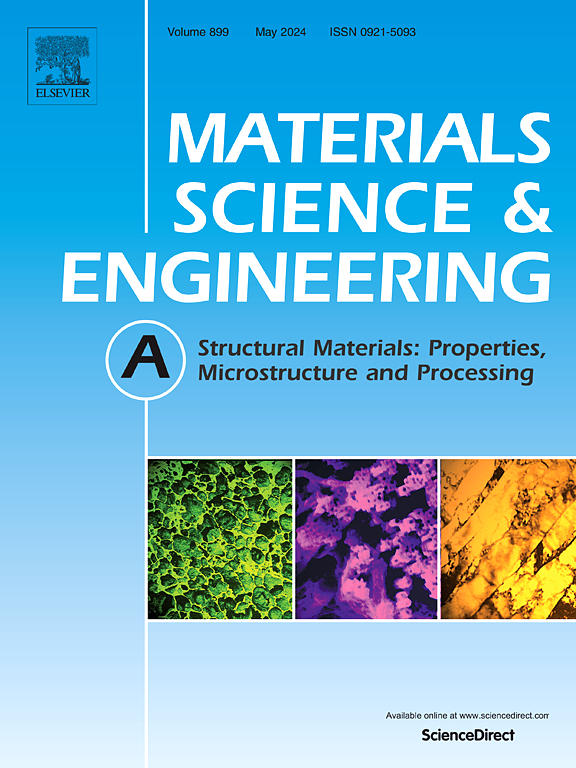L-PBF IN718锁孔孔隙演化及诱发损伤机制的非原位XCT跟踪
IF 6.1
2区 材料科学
Q1 MATERIALS SCIENCE, MULTIDISCIPLINARY
引用次数: 0
摘要
锁孔是激光粉末床熔融(L-PBF)增材制造中普遍存在的缺陷。虽然锁孔孔的形成机制已经很清楚,但对其在载荷作用下的变形及其对构件损伤行为的影响的研究仍然缺乏。本研究通过非原位XCT力学试验,跟踪了带锁孔孔的L-PBF IN718构件在同轴拉伸载荷作用下的动态演化过程。通过浸入边界有限元法(IBFEM),将基于XCT重建的数字模型直接应用于高保真结构力学模拟。结果表明,小孔引起了显著的应力集中,孔周围的最大von Mises应力超过材料屈服强度的8倍。在部件的整个生命周期中,锁孔孔的闭合趋势可以忽略不计,即使在开裂后,平均球度也高达0.97。此外,对于最小截面厚度为2 mm的L-PBF IN718部件,埋深大于360 μm的锁孔孔不会导致其过早开裂。由孔隙分布偏斜引起的不均匀变形并没有改变构件开裂位置的优先级。打开的锁孔孔,特别是与其他锁孔孔相邻的锁孔孔,是开裂的起始点。此外,孔隙长轴与加载方向之间的夹角小于50°的锁孔孔隙的积累被认为是裂缝破坏的重要前兆。这项研究增强了对控制载荷诱导的锁孔孔隙演化和相关损伤行为的机制的理解。本文章由计算机程序翻译,如有差异,请以英文原文为准。
Ex-situ XCT tracking of keyhole pore evolution and induced damage mechanisms in L-PBF IN718 for mechanical testing
Keyhole pores are a prevalent defect in laser powder bed fusion (L-PBF) additive manufacturing. Although the formation mechanism of keyhole pores is well understood, research on their deformation under load and subsequent impact on component damage behavior remains lacking. In this study, the dynamic evolution of L-PBF IN718 components with keyhole pores under coaxial tensile load was tracked through ex-situ XCT mechanical testing. The digital models derived from XCT reconstructions were directly applied to high-fidelity structural mechanics simulations via the immersed boundary finite element method (IBFEM). The results indicate that keyhole pores induced significant stress concentrations, with the maximum von Mises stress around the pores exceeding 8 times the material's yield strength. Keyhole pores exhibited a negligible tendency for closure throughout the entire lifecycle of the component, with a mean sphericity up to 0.97 even after cracking. Furthermore, for L-PBF IN718 components with a minimum section thickness of 2 mm, keyhole pores buried deeper than 360 μm beneath the surface did not contribute to premature cracking. The uneven deformation caused by skewed pore distribution did not alter the priority of cracking locations in the components. Open keyhole pores, particularly those adjacent to other keyhole pores, served as the initial points of cracking. Additionally, the accumulation of keyhole pores with angles less than 50° (between the long axis of the pore and the loading direction) was identified as a significant precursor to cracking failure. This study enhances understanding of the mechanisms governing load-induced keyhole pore evolution and the associated damage behavior.
求助全文
通过发布文献求助,成功后即可免费获取论文全文。
去求助
来源期刊

Materials Science and Engineering: A
工程技术-材料科学:综合
CiteScore
11.50
自引率
15.60%
发文量
1811
审稿时长
31 days
期刊介绍:
Materials Science and Engineering A provides an international medium for the publication of theoretical and experimental studies related to the load-bearing capacity of materials as influenced by their basic properties, processing history, microstructure and operating environment. Appropriate submissions to Materials Science and Engineering A should include scientific and/or engineering factors which affect the microstructure - strength relationships of materials and report the changes to mechanical behavior.
 求助内容:
求助内容: 应助结果提醒方式:
应助结果提醒方式:


